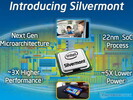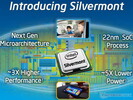Intel Pentium J2900 vs Intel Pentium J2850
Intel Pentium J2900
► remove from comparison
The Intel Pentium J2900 is a power efficient quad-core SoC for desktops and nettops. It is clocked at 2.41 - 2.67 GHz and part of the Bay Trail-D platform. Thanks to the specially optimized 22 nanometer low-power process (P1271) with tri-gate transistors, performance and energy efficiency have been significantly improved compared to its predecessor.
Architecture
The processor cores are based on the new Silvermont architecture, which is an out-of-order design for the first time. The increased utilization of the pipeline and many other improvements (optimized branch prediction, increased buffers, enhanced decoders) have increased the performance per clock by about 50 percent. At the same time, however, the Hyper-Threading feature of the previous generation has been removed. Other major changes are the support for new instruction set extensions such as SSE 4.1 and 4.2 as well as AES-NI (depending on the model).
Performance
Thanks to 4 CPU cores and a clock speed of up to 2.67 GHz, the Pentium J2900 is significantly faster than previous Intel Atoms, e.g. the D2560. Presumably, the J2900 is just slightly slower than the AMD Kabini APU A6-5200. For everyday tasks such as Internet or Office the performance is adequate, but not for very complex software or modern games.
Graphics
The HD Graphics (Bay Trail) is based on the Intel Gen7 architecture, which supports DirectX 11 and is also found in the Ivy Bridge series (e.g. HD Graphics 4000). With only 4 EUs (Execution Units) and a relatively low clock speed of up 688 - 896 MHz, the GPU is even slower than the HD Graphics (Ivy Bridge). Therefore, only older and less demanding games will run fluently.
Power Consumption
The entire SoC is rated at a TDP of 10 watts. Thus, the chip can be used in compact nettops.
Intel Pentium J2850
► remove from comparison
The Intel Pentium J2850 is a power efficient quad-core SoC for desktops and nettops. It is clocked at up to 2.4 GHz and part of the Bay Trail-D platform. Thanks to the specially optimized 22 nanometer low-power process (P1271) with tri-gate transistors, performance and energy efficiency have been significantly improved compared to its predecessor.
Architecture
The processor cores are based on the new Silvermont architecture, which is an out-of-order design for the first time. The increased utilization of the pipeline and many other improvements (optimized branch prediction, increased buffers, enhanced decoders) have increased the performance per clock by about 50 percent. At the same time, however, the Hyper-Threading feature of the previous generation has been removed. Other major changes are the support for new instruction set extensions such as SSE 4.1 and 4.2 as well as AES-NI (depending on the model).
Performance
Thanks to 4 CPU cores and a clock speed of up to 2.4 GHz, the Pentium J2850 is significantly faster than previous Intel Atoms, e.g. the D2560. Presumably, the J2850 even beats some of the Kabini APUs like the AMD A4-5000. For everyday tasks such as Internet or Office the performance is adequate, but not for very complex software or modern games.
Graphics
The HD Graphics (Bay Trail) is based on the Intel Gen7 architecture, which supports DirectX 11 and is also found in the Ivy Bridge series (e.g. HD Graphics 4000). With only 4 EUs (Execution Units) and a relatively low clock speed of up to 792 MHz, the GPU is even slower than the HD Graphics (Ivy Bridge). Therefore, only older and less demanding games will run fluently.
Power Consumption
The entire SoC is rated at a TDP of 10 watts. Thus, the chip can be used in compact nettops.
| Model | Intel Pentium J2900 | Intel Pentium J2850 | ||||||||||||||||
| Series | Intel Pentium | Intel Pentium | ||||||||||||||||
| Codename | Bay Trail-D | Bay Trail-D | ||||||||||||||||
| Series: Pentium Bay Trail-D |
|
| ||||||||||||||||
| Clock | 2410 - 2667 MHz | 2400 MHz | ||||||||||||||||
| L1 Cache | 224 KB | 224 KB | ||||||||||||||||
| L2 Cache | 2 MB | 2 MB | ||||||||||||||||
| Cores / Threads | 4 / 4 | 4 / 4 | ||||||||||||||||
| TDP | 10 Watt | 10 Watt | ||||||||||||||||
| Technology | 22 nm | 22 nm | ||||||||||||||||
| max. Temp. | 105 °C | 100 °C | ||||||||||||||||
| Features | HD Graphics (Bay Trail, 688 - 896 MHz), Dual-Channel DDR3(L)-1333 Memory Controller, CPU Burst | HD Graphics (Bay Trail, max. 792 MHz), Dual-Channel DDR3-1333 Memory Controller | ||||||||||||||||
| iGPU | Intel HD Graphics (Bay Trail) (688 - 896 MHz) | Intel HD Graphics (Bay Trail) (688 - 792 MHz) | ||||||||||||||||
| Architecture | x86 | x86 | ||||||||||||||||
| $94 U.S. | $94 U.S. | |||||||||||||||||
| Announced | ||||||||||||||||||
| Manufacturer | ark.intel.com | ark.intel.com | ||||||||||||||||
| Socket | FCBGA1170 |
Benchmarks
* Smaller numbers mean a higher performance
1 This benchmark is not used for the average calculation


 Deutsch
Deutsch English
English Español
Español Français
Français Italiano
Italiano Nederlands
Nederlands Polski
Polski Português
Português Русский
Русский Türkçe
Türkçe Svenska
Svenska Chinese
Chinese Magyar
Magyar